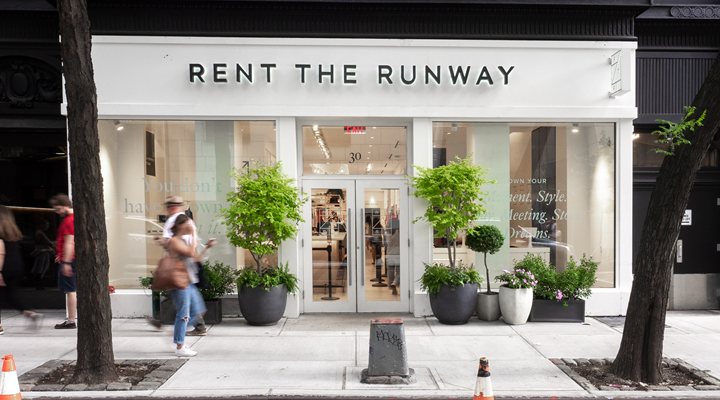Rent the Runway, a US-based fashion rental and retail company, recently announced the appointment of Natalie McGrath as its new chief marketing officer, effective March 4. An alum of payments platform Afterpay and fashion brands including Coach, Boohoo, and Bandier, McGrath’s hire signals the next phase of Rent the Runway founder and CEO Jenn Hyman’s attempts to reinvigorate the company. As Hyman stated in a press release, “With a world-class marketer like Natalie McGra
McGrath at the helm of this iconic brand, I’m looking forward to seizing on the incredible growth opportunity I believe is ahead of us, and continuing to lead the category we created. We are focused on supercharging our market share by creating emotional and lasting connections with our core customers — and reaching net-new audiences.”
In recent years, Rent the Runway has faced its fair share of financial and structural challenges.
According to the brand’s third-quarter report released last December, revenue was $72.5 million, a 6.3 per cent decrease year-over-year from the same period in 2022. The report also revealed that 131,735 active subscribers closed their accounts, representing a 2 per cent decrease from the end of the third quarter of fiscal year 2022.
Even though the company raised over $500 million in equity over its first decade in business, it has struggled to turn a profit. In 2021, Rent the Runway went public at $21 per share, but hasn’t traded above $5 since August 2022 and is currently valued at approximately $0.41 per share.
In 2022, the company laid off about a quarter of its staff as it struggled to recover from a pandemic-influenced loss of subscriptions, approximately 60 per cent of subscribers paused or entirely canceled subscriptions mid-lockdown.
In January, the company underwent another major restructuring, which included Rent the Runway’s longtime president and chief operating officer Anushka Salinas exiting the team and layoffs impacting approximately 10 per cent of its staff.
Coresight Research analyst Sunny Zheng told Inside Retail that Rent the Runway’s struggles stem from several factors, including “increased competition, changing consumer preferences, operational complexities, and financial pressures”.
One example of this is the launch of Urban Outfitter’s clothing rental platform Nuuly, which offers more affordable and trendy options targeted towards a younger millennial and Gen Z consumer base.
Neil Saunders, managing director and retail analyst at GlobalData, added, “Rent the Runway is not in a happy place and has not been in a happy place for quite some time.
“Several unfortunate headwinds have hit the business at the same time, including a casualisation of what people wear, fewer people going to offices for work, and the cost-of-living crisis deterring people from subscriptions. On top of this, the company had inventory issues last year which meant it did not have the products, or enough of the products, that renters wanted.”
However, with strategic shifts set in place by the company, things seem to be turning around for Rent the Runway.
How Rent the Runway is working to rebrand itself
While the company has struggled to turn a profit through its original business model — renting mid-tier to high-end clothing options for female working professionals — Rent the Runway has recently been leveraging partnerships with established marketplaces, such as ThredUp in 2020, and Saks Off 5th in 2022, to generate profits and build consumer awareness.
In January, the company announced a potentially game-changing partnership with Amazon, which will see it launch its own storefront on Amazon’s website. Rent the Runway will sell hundreds of styles from its inventory, as well as select items from its Design Collective range, which consists of high-quality fashion created by emerging designers leveraging the company’s member data and industry trends.
At the time, Hyman said that collaborating with Amazon Fashion would drive “incredible brand awareness”.
“We believe strategic relationships like this can ignite a new engine of growth for our business,” she said. “They also showcase demand for our products beyond our community and allow more customers to experience exclusive data-driven fashion from our top design partners.”
Coresight’s Zheng said the strategy could be seen as a proactive step towards addressing some of the challenges Rent the Runway is facing.
“While partnerships can provide short-term benefits, the long-term success of Rent the Runway will hinge on its ability to deliver value to customers, maintain operational efficiency, and achieve financial stability,” she said.
How should the industry adapt to rapidly changing consumer concerns?
Data from market intelligence and advisory firm Mordor Intelligence indicates that not all hope is lost within the fashion rental industry.
A report conducted by the firm estimated that the online clothing rental market will be worth $1.77 billion by the end of 2024, and is projected to reach $2.47 billion by 2029, growing at a compound annual growth rate of 6.79 per cent during the forecast period.
Zheng provided a cautious prediction of the state of this market: “We estimated that the fashion rental market saw a low-single-digit percentage decline in 2023 as the pent-up demand for occasion wear faded away,” she said.
“We expect the decline to deepen in 2024 before a slight recovery in 2025. Although we expect the fashion rental market may grow in 2025 and beyond, with key players’ revenues increasing, the profitability of fashion rental companies remains uncertain given that the sector still requires significant investment, especially for online apparel rental.”
Zheng shared three key ways rental businesses can adapt to changing consumer trends:
Diversification of offerings
“Retailers can expand their rental offerings beyond special occasion dresses to include other categories such as home goods, catering to a wider range of consumer needs and preferences.”
Investment in technology
“Embracing technology solutions such as inventory management systems, data analytics, and personalised recommendation engines can enhance the rental experience, improve operational efficiency, and drive customer engagement and loyalty.”
Strategic partnerships
“Collaborating with complementary brands, influencers, and platforms can expand reach and create mutually beneficial opportunities for growth and innovation.”

